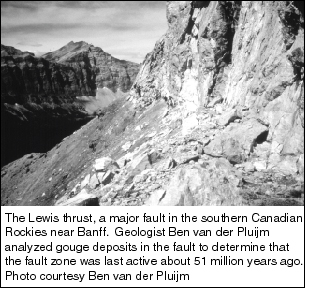The University Record, November 2, 1998
Geologists use ‘nature’s grease’ to date fault activity
By Sally Pobojewski
News and Information Services
 U-M scientists have found a way to use gouge—soft, chalky material created in the contact zone between moving fault blocks—to date near-surface fault activity and learn more about the fault’s current strength.
U-M scientists have found a way to use gouge—soft, chalky material created in the contact zone between moving fault blocks—to date near-surface fault activity and learn more about the fault’s current strength.
Although geologists have been able to determine the age of deep faults for more than a decade, establishing the absolute age of near-surface faults has been difficult, according to Ben van der Pluijm, professor of geological sciences.
Fault activity tends to occur in cycles of a few million years of movement followed by long quiet periods, according to van der Pluijm. “It’s important to know whether a fault has recently been active, for example, when it is located near a nuclear reactor or waste repository. It also is important to know how strong a fault is for earthquake risk assessment,” and the information “will be useful to geologists looking for oil and gas deposits, who are concerned with fluid seals.”
At a meeting of the Geological Society of America Oct. 26, van der Pluijm presented data from his analysis of gouge deposits in major thrust faults in the southern Canadian Rockies near Banff. “Until now, we could only estimate the last date of activity on these faults, based on their location in sedimentary deposits, as somewhere between 60 million to 70 million years ago,” van der Pluijm said. “Based on our new analysis, we now believe it occurred about 51 million years ago.
“Most geologists consider gouge to be grinding scum created in a mechanical process when rocks move past each other,” van der Pluijm said. “We can show that 80 percent of gouge deposits are actually created by chemical reactions, rather than from rock grinding. The change involves a dehydration process and the transformation of original clays called smectite into other forms of clay called illite. These changes have significant mechanical and hydrologic consequences.”
Clays are inherently weak, making it possible for a fault to move more easily. This is not necessarily a bad thing, if you live near one. “Weak faults generate a lot of small slippage motion, instead of one huge slip producing a catastrophic earthquake,” he said. “In subduction zones and other major faults, gouge may work like vaseline between bricks, greasing the fault and making it easier for blocks to slide.”
Because heat and pressure increase deeper beneath the Earth’s surface, the chemistry involved when deep faults slip produces a completely different type of material than gouge, van der Pluijm added.
All van der Pluijm and his colleagues need to unlock the secrets stored in gouge is advanced X-ray equipment, sophisticated radiogenic dating technology and six months of painstaking processing time. They use X-ray analysis to determine the nature and orientation of sub-micron-sized particles in gouge. “If the grains are stacked up like playing cards, they slip easily. If they are bent and interlocked, the fault is much stronger,” van der Pluijm said. To date fault activity, the scientists use argon isotopic dating technology to date grains of newly grown clays in gouge deposits.
Next summer, van der Pluijm and co-workers plan to analyze gouge deposits from California’s San Andreas fault. The research is funded by the National Science Foundation and the American Chemical Society.
Collaborators include Peter Vrolijk, a research scientist at Exxon, and Donald R. Peacor, professor of geological sciences, and Chris M. Hall, assistant research scientist, both from the U-M.
You can always drop us a line: [email protected].

